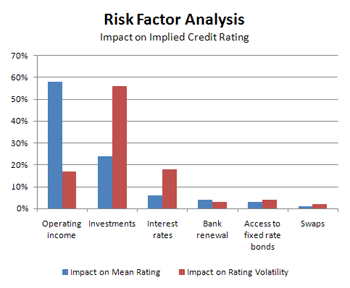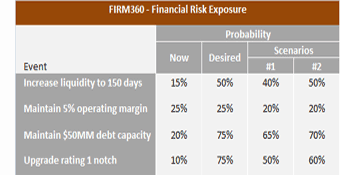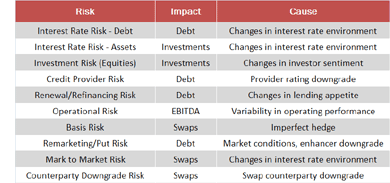The recent bond market meltdown has led a number of hospitals to renounce all forms of financial risk, shying away from products such as variable debt and interest rate swaps. By applying ERM techniques to the capital structure, hospitals could make better decisions and trade a reasonable amount of risk for a lower cost of funds.
Approach
Enterprise risk management is a risk-based approach to running a business with the goal of maximizing enterprise value for stakeholders. Already in use by hospitals in the clinical, human capital and legal and compliance domains, ERM involves four basic steps: identify risks relevant to the organization's objectives, quantify their likelihood and
magnitude of impact, mitigate risks and monitor progress.
Identification
The first step in the process is to identify risks. Risks are everywhere in the capital markets and can find their way into various areas of a hospital's capital structure, including variable rate or "put" debt, interest rate swaps and investment portfolios. For example, variable rate debt may create interest rate risk, put risk, remarketing risk and bank LOC renewal risk. Identifying risks requires a complete and systematic review of the balance sheet, capital structure, bond indentures and loan agreements. As with any other exploratory procedure, it helps to know what you're looking for, but it's not unusual to uncover unexpected ticking time bonds which could have a significant impact on financial position.
Quantification
The next step is to quantify risks. In corporate finance, managers are taught that the expected return (benefit) of a product should be adjusted for the probability it will be realized. Generally the more risk, the higher the reward. Risk can be measured based on its impact on various key ratios and other metrics such as liquidity, coverage, covenant compliance, ratings, etc. based on their probability of occurrence and magnitude of impact. This is the most challenging step in the process, because traditional forecasting techniques are ineffective to model risks that involve many variables and do not occur in "silos."
 Mitigation
Mitigation
Once risks are quantified, the hospital is in position to ensure that the rewards are appropriate and consistent with the organization's comfort zone, or risk appetite. To some borrowers, mitigation means avoidance. For example, a board's desire to completely eliminate swaps may be the result of a traumatic experience which created the perception that the product is a black box and risk cannot be assessed nor managed.
Unfortunately, many organizations have bought good products with an incomplete understanding of the risks involved, usually due to a lack of objective advice. For example, a change in interest expense on variable rate debt due to rising interest rates will tend to be accompanied by an improvement in pay-fixed swap mark-to-market, and a
decline in fixed income investment net asset values. To quantify risk requires stochastic (random) modeling. Some investment banks have developed models to simulate the optimal mix of fixed vs. variable rate debt, but these models rarely pass the independence "sniff test" and live mostly outside accepted ERM tenets. Models should deliver practical, actionable outcomes such as the probability of downgrade in the next five years between scenarios.
 Monitoring
Monitoring
This last step in the ERM methodology is critical. Risk management must be embedded into the overall enterprise risk management process and ongoing capital and strategic planning. Because what made sense last year may not work today, simple procedures should be developed to revisit assumptions on a regular basis or whenever a material change occurs in the hospital's operating environment or capital structure.
Conclusion
Hospitals cannot be expected to make rational decisions about their capital structure without the ability to identify and measure financial risk. It's time to apply the lessons learned from the recent bond market debacle and extend ERM to the financial domain so that hospitals can factor risk into their capital planning and overall financial decision-making process. The future of their mission may depend on it.
HFA Partners is an independent financial advisory firm dedicated to assisting non-profit healthcare providers with managing debt and navigating today's capital markets. Learn more about HFA Partners.
Approach
Enterprise risk management is a risk-based approach to running a business with the goal of maximizing enterprise value for stakeholders. Already in use by hospitals in the clinical, human capital and legal and compliance domains, ERM involves four basic steps: identify risks relevant to the organization's objectives, quantify their likelihood and
magnitude of impact, mitigate risks and monitor progress.
Identification
The first step in the process is to identify risks. Risks are everywhere in the capital markets and can find their way into various areas of a hospital's capital structure, including variable rate or "put" debt, interest rate swaps and investment portfolios. For example, variable rate debt may create interest rate risk, put risk, remarketing risk and bank LOC renewal risk. Identifying risks requires a complete and systematic review of the balance sheet, capital structure, bond indentures and loan agreements. As with any other exploratory procedure, it helps to know what you're looking for, but it's not unusual to uncover unexpected ticking time bonds which could have a significant impact on financial position.

Quantification
The next step is to quantify risks. In corporate finance, managers are taught that the expected return (benefit) of a product should be adjusted for the probability it will be realized. Generally the more risk, the higher the reward. Risk can be measured based on its impact on various key ratios and other metrics such as liquidity, coverage, covenant compliance, ratings, etc. based on their probability of occurrence and magnitude of impact. This is the most challenging step in the process, because traditional forecasting techniques are ineffective to model risks that involve many variables and do not occur in "silos."

Once risks are quantified, the hospital is in position to ensure that the rewards are appropriate and consistent with the organization's comfort zone, or risk appetite. To some borrowers, mitigation means avoidance. For example, a board's desire to completely eliminate swaps may be the result of a traumatic experience which created the perception that the product is a black box and risk cannot be assessed nor managed.
Unfortunately, many organizations have bought good products with an incomplete understanding of the risks involved, usually due to a lack of objective advice. For example, a change in interest expense on variable rate debt due to rising interest rates will tend to be accompanied by an improvement in pay-fixed swap mark-to-market, and a
decline in fixed income investment net asset values. To quantify risk requires stochastic (random) modeling. Some investment banks have developed models to simulate the optimal mix of fixed vs. variable rate debt, but these models rarely pass the independence "sniff test" and live mostly outside accepted ERM tenets. Models should deliver practical, actionable outcomes such as the probability of downgrade in the next five years between scenarios.

This last step in the ERM methodology is critical. Risk management must be embedded into the overall enterprise risk management process and ongoing capital and strategic planning. Because what made sense last year may not work today, simple procedures should be developed to revisit assumptions on a regular basis or whenever a material change occurs in the hospital's operating environment or capital structure.
Conclusion
Hospitals cannot be expected to make rational decisions about their capital structure without the ability to identify and measure financial risk. It's time to apply the lessons learned from the recent bond market debacle and extend ERM to the financial domain so that hospitals can factor risk into their capital planning and overall financial decision-making process. The future of their mission may depend on it.
HFA Partners is an independent financial advisory firm dedicated to assisting non-profit healthcare providers with managing debt and navigating today's capital markets. Learn more about HFA Partners.

